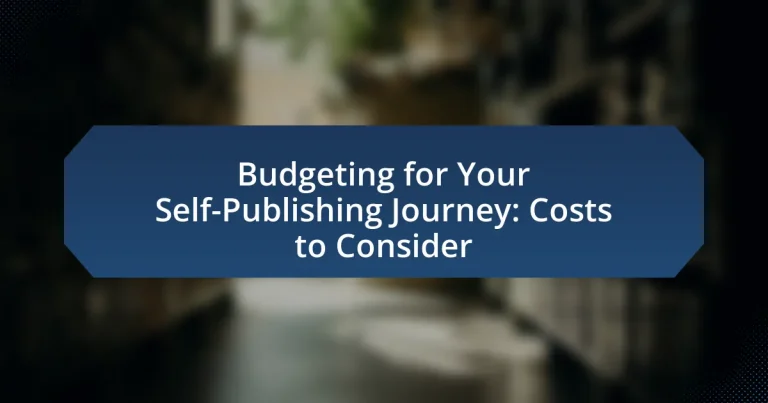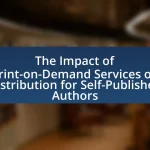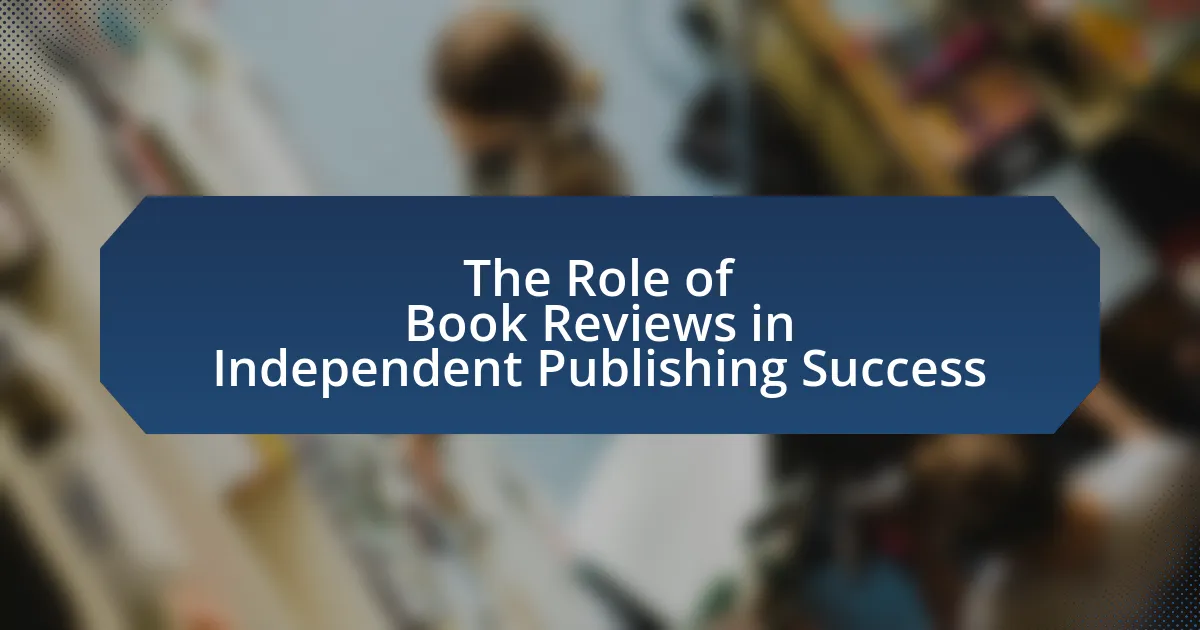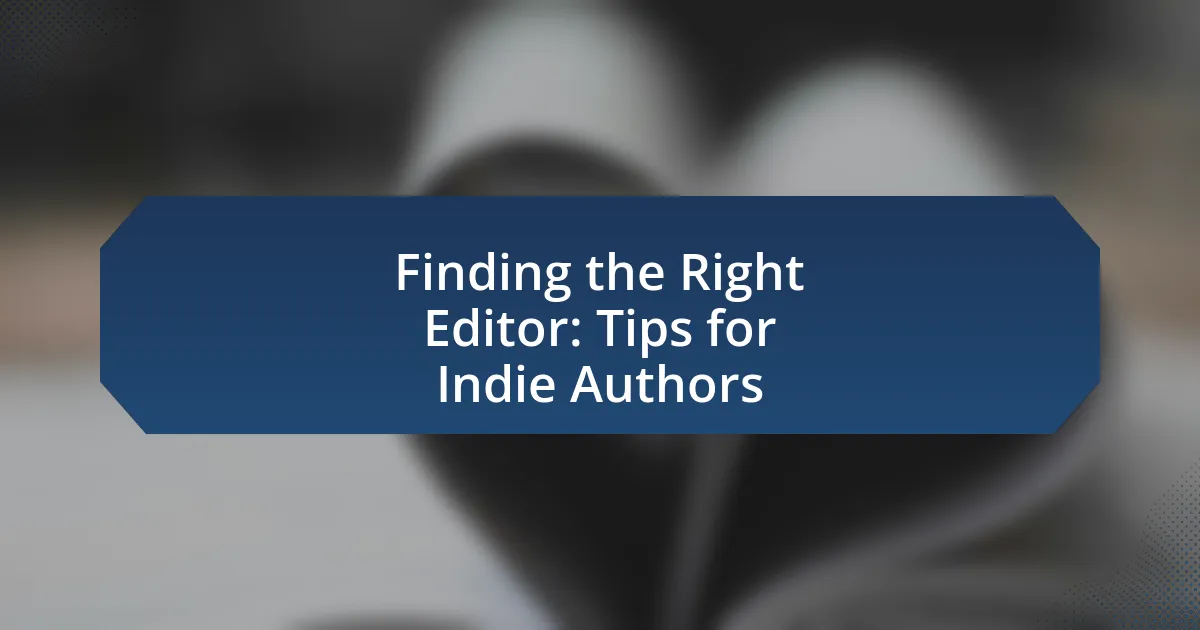The article focuses on budgeting for self-publishing, detailing the key costs authors should consider throughout the process. It outlines essential expenses such as editing, cover design, formatting, distribution, and marketing, providing specific cost ranges for each category. Additionally, the article discusses the impact of these costs on overall budgeting, strategies for finding affordable services, and the importance of effective financial management to ensure a successful self-publishing venture. Legal considerations and common pitfalls in budgeting are also highlighted, emphasizing the need for careful planning and resource allocation.
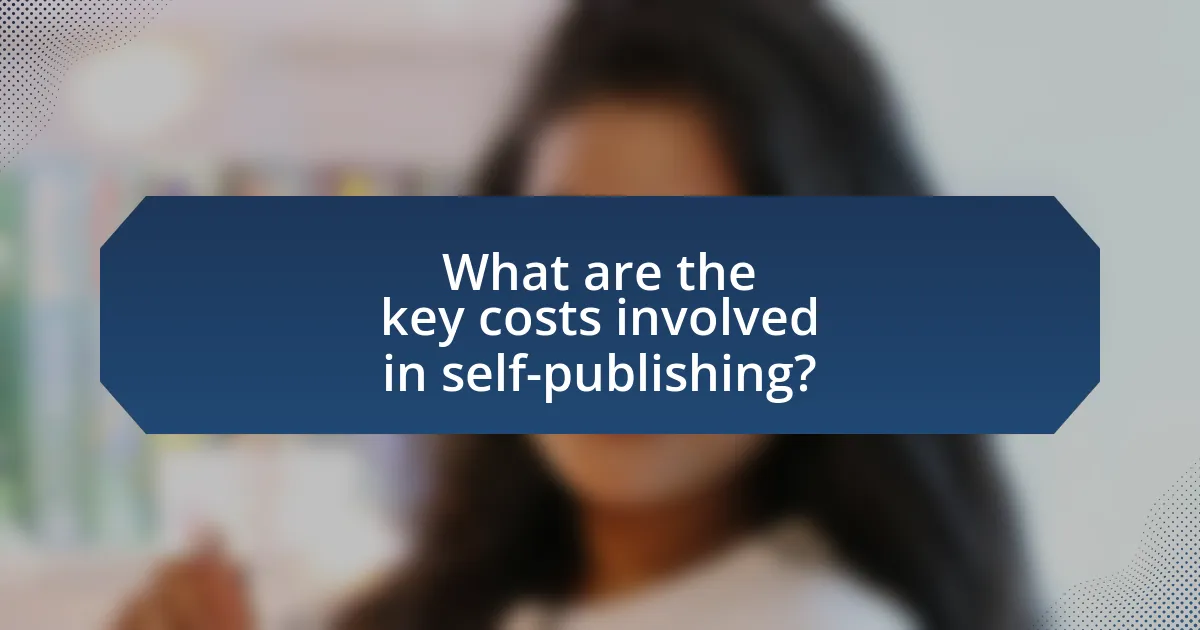
What are the key costs involved in self-publishing?
The key costs involved in self-publishing include editing, cover design, formatting, distribution, and marketing. Editing typically ranges from $500 to $3,000, depending on the manuscript’s length and the editor’s expertise. Cover design can cost between $100 and $1,500, influenced by the designer’s experience and the complexity of the artwork. Formatting for print and eBook versions usually costs between $50 and $300. Distribution fees vary, with platforms like Amazon taking a percentage of sales, often around 30%. Marketing expenses can range from $100 to several thousand dollars, depending on the strategies employed, such as social media ads or book launch events. These costs collectively contribute to the overall budget required for a successful self-publishing venture.
How do editing costs impact your self-publishing budget?
Editing costs significantly impact your self-publishing budget by consuming a substantial portion of the overall expenses. For instance, professional editing services can range from $0.01 to $0.03 per word, meaning that for a 70,000-word manuscript, authors may spend between $700 and $2,100. This financial commitment necessitates careful budgeting, as it directly influences the funds available for other essential aspects of self-publishing, such as cover design, marketing, and distribution. Therefore, understanding and planning for editing costs is crucial for maintaining a balanced self-publishing budget.
What types of editing should you consider for your book?
You should consider several types of editing for your book: developmental editing, copyediting, and proofreading. Developmental editing focuses on the overall structure, content, and flow of the manuscript, ensuring that the story or argument is coherent and engaging. Copyediting addresses grammar, punctuation, and style, refining the text for clarity and consistency. Proofreading is the final step, catching any remaining typos or errors before publication. Each type of editing plays a crucial role in enhancing the quality of the book, ultimately impacting reader satisfaction and sales.
How can you find affordable editing services?
To find affordable editing services, start by researching freelance platforms such as Upwork, Fiverr, and Reedsy, where you can compare rates and reviews from various editors. These platforms often feature a range of pricing options, allowing you to select services that fit your budget. Additionally, consider reaching out to local universities or writing programs, as students or recent graduates may offer editing services at lower rates while gaining experience. According to a survey by Editorial Freelancers Association, the average hourly rate for editing services can vary widely, but many freelancers offer competitive pricing to attract clients.
What are the design costs associated with self-publishing?
The design costs associated with self-publishing typically range from $500 to $5,000, depending on the complexity and quality of the design work required. This cost includes expenses for cover design, interior formatting, and any additional graphic elements needed for the book. For instance, a professional cover design can cost between $300 and $1,500, while interior formatting services may range from $100 to $1,000. These figures are supported by industry standards and surveys conducted by organizations such as the Alliance of Independent Authors, which highlight the importance of investing in quality design to enhance marketability and reader engagement.
Why is cover design crucial for your book’s success?
Cover design is crucial for a book’s success because it serves as the first point of interaction between the reader and the book, significantly influencing purchasing decisions. Research indicates that 75% of consumers judge a book by its cover, highlighting the importance of visual appeal in attracting potential readers. A well-designed cover not only conveys the genre and tone of the book but also establishes credibility and professionalism, which can enhance the author’s reputation. Furthermore, effective cover design can increase visibility in a crowded market, making it easier for readers to find and choose the book over competitors.
What should you budget for interior formatting?
You should budget between $1 to $5 per page for interior formatting. This cost varies based on the complexity of the layout and the experience of the formatter. For example, a standard novel may cost around $2 to $3 per page, while more intricate designs, such as those for illustrated books or textbooks, can reach up to $5 per page. This pricing reflects industry standards and the typical rates charged by professional formatting services, ensuring that authors allocate sufficient funds for quality formatting that enhances readability and presentation.
How do marketing expenses fit into your self-publishing budget?
Marketing expenses are a crucial component of your self-publishing budget, as they directly influence the visibility and sales of your book. Allocating a specific percentage of your overall budget, typically between 10% to 30%, for marketing ensures that you can effectively reach your target audience and promote your work. Research indicates that authors who invest in marketing see a significant increase in book sales, with some studies showing that effective marketing can lead to a 300% return on investment. Therefore, integrating marketing expenses into your self-publishing budget is essential for maximizing your book’s potential in a competitive market.
What marketing strategies require financial investment?
Marketing strategies that require financial investment include paid advertising, influencer partnerships, and professional public relations services. Paid advertising, such as Google Ads or social media ads, necessitates a budget for ad placements to reach targeted audiences effectively. Influencer partnerships involve compensating influencers to promote products, which can vary widely in cost depending on the influencer’s reach and engagement. Professional public relations services often require fees for press releases, media outreach, and event management to enhance visibility and credibility. These strategies are essential for gaining traction in a competitive market and often yield measurable returns on investment.
How can you effectively allocate your marketing budget?
To effectively allocate your marketing budget, prioritize your spending based on the channels that yield the highest return on investment (ROI). Research indicates that digital marketing channels, such as social media advertising and email marketing, often provide better ROI compared to traditional methods. For instance, a study by HubSpot found that businesses earn an average of $36 for every $1 spent on email marketing. Additionally, segment your budget by assessing your target audience’s preferences and behaviors, ensuring that funds are directed towards the most impactful strategies. This data-driven approach allows for more efficient use of resources, maximizing the effectiveness of your marketing efforts.

What additional costs should you consider when self-publishing?
When self-publishing, additional costs to consider include editing, cover design, formatting, marketing, and distribution fees. Editing can range from $500 to $3,000 depending on the manuscript’s length and complexity, ensuring the text is polished and professional. Cover design typically costs between $300 and $1,500, as a compelling cover is crucial for attracting readers. Formatting for both print and digital versions may incur fees of $100 to $500, depending on the complexity of the layout. Marketing expenses can vary widely, from $100 for basic social media promotions to several thousand dollars for comprehensive campaigns. Lastly, distribution fees, including print-on-demand services or e-book platforms, can also add up, often taking a percentage of sales or charging upfront costs. These figures highlight the importance of budgeting comprehensively for a successful self-publishing venture.
How do printing costs vary for self-published authors?
Printing costs for self-published authors vary based on factors such as print quantity, book format, and printing method. For instance, authors printing in bulk typically benefit from lower per-unit costs due to economies of scale, while print-on-demand services often charge higher rates for smaller quantities. Additionally, the choice between black-and-white or color printing significantly impacts costs, with color printing generally being more expensive. According to a study by the Independent Book Publishers Association, the average cost to print a standard paperback book ranges from $2 to $5 per copy, depending on these variables.
What factors influence the cost of printing your book?
The cost of printing your book is influenced by several key factors, including print quantity, paper quality, binding type, and color versus black-and-white printing. Print quantity significantly affects cost, as larger print runs typically reduce the per-unit price due to economies of scale. Paper quality impacts the overall expense; higher-quality paper increases costs, while standard options are more economical. The binding type, whether paperback or hardcover, also plays a crucial role, with hardcover generally being more expensive. Additionally, choosing color printing over black-and-white can substantially raise costs, as color inks and processes are pricier. These factors collectively determine the final printing cost of a book.
How can you minimize printing expenses?
To minimize printing expenses, utilize digital printing methods and print on demand services. Digital printing reduces costs by eliminating the need for large print runs and allows for smaller quantities, which is particularly beneficial for self-publishing authors who may not need extensive inventory. According to a study by the Printing Industries of America, digital printing can lower costs by up to 50% compared to traditional offset printing for small runs. Additionally, choosing black and white printing over color can further decrease expenses, as color printing typically incurs higher costs. Implementing these strategies effectively reduces overall printing expenditures in the self-publishing process.
What are the costs associated with distribution and sales channels?
The costs associated with distribution and sales channels include printing costs, shipping fees, retailer discounts, and platform fees. Printing costs vary based on the format and quantity of books produced, while shipping fees depend on the destination and shipping method chosen. Retailer discounts typically range from 30% to 55% of the retail price, impacting the author’s earnings. Additionally, online platforms may charge fees for listing and selling books, which can be a percentage of sales or a flat fee per transaction. These costs collectively influence the overall budget for self-publishing and must be carefully considered to ensure profitability.
How do different platforms affect your distribution costs?
Different platforms significantly influence distribution costs by varying their fee structures and services offered. For instance, Amazon’s Kindle Direct Publishing charges a 30% to 65% royalty fee depending on the pricing model, while platforms like IngramSpark have a setup fee and take a percentage of sales, which can lead to higher upfront costs but potentially broader distribution. Additionally, platforms such as Draft2Digital offer free distribution but take a cut from sales, impacting overall profitability. These differences in fees and services directly affect the net revenue authors receive from their works, making it crucial for self-publishers to analyze each platform’s cost implications carefully.
What fees should you expect from online retailers?
Online retailers typically charge several fees, including shipping fees, handling fees, and transaction fees. Shipping fees vary based on the retailer’s policies and the delivery method chosen, while handling fees may apply for packaging and processing orders. Transaction fees are often a percentage of the sale price and can range from 2% to 5%, depending on the payment processor used. For example, platforms like Amazon and Etsy charge specific fees for listing products and processing payments, which can impact the overall cost of selling through these channels.
What legal costs might arise during the self-publishing process?
Legal costs during the self-publishing process may include copyright registration fees, contract review expenses, and potential legal consultations. Copyright registration typically costs between $35 to $55 in the United States, providing legal protection for the author’s work. Contract review expenses can arise when hiring a lawyer to examine publishing agreements, which may range from $150 to $500 per hour, depending on the attorney’s experience. Additionally, if disputes arise regarding intellectual property or contractual obligations, legal consultations may incur further costs, averaging $100 to $300 per hour. These expenses highlight the importance of budgeting for legal considerations in self-publishing.
Why is copyright registration important for self-published authors?
Copyright registration is important for self-published authors because it provides legal protection for their original works. By registering their copyright, authors gain the ability to enforce their rights against unauthorized use, which can deter infringement and facilitate legal action if necessary. Additionally, registered works are eligible for statutory damages and attorney’s fees in case of infringement, which can significantly enhance the author’s ability to recover losses. According to the U.S. Copyright Office, registration is a prerequisite for filing a lawsuit for infringement, making it a crucial step for authors seeking to protect their intellectual property effectively.
What other legal considerations should you budget for?
You should budget for copyright registration, which protects your intellectual property and prevents unauthorized use of your work. Additionally, consider legal fees for contracts with editors, designers, and distributors to ensure clear agreements and protect your interests. Liability insurance is also important to cover potential legal claims related to your published content. According to the U.S. Copyright Office, registering your copyright provides legal advantages, including the ability to sue for damages in case of infringement.

How can you effectively manage your self-publishing budget?
To effectively manage your self-publishing budget, create a detailed budget plan that outlines all potential costs associated with the self-publishing process. This plan should include expenses such as editing, cover design, formatting, marketing, and distribution. According to a survey by the Alliance of Independent Authors, self-published authors typically spend between $1,000 and $5,000 on these services, highlighting the importance of budgeting accurately to avoid overspending. By tracking these expenses and adjusting your budget as needed, you can ensure that you stay within your financial limits while still producing a quality product.
What budgeting strategies can help you stay on track?
Effective budgeting strategies that can help you stay on track include the zero-based budgeting method, the 50/30/20 rule, and regular expense tracking. The zero-based budgeting method requires you to allocate every dollar of your income to specific expenses, savings, or debt repayment, ensuring that your budget balances to zero at the end of the month. The 50/30/20 rule suggests that you allocate 50% of your income to needs, 30% to wants, and 20% to savings or debt repayment, providing a clear framework for managing your finances. Regular expense tracking involves monitoring your spending habits through apps or spreadsheets, allowing you to identify areas where you can cut costs and stay within your budget. These strategies are supported by financial experts who emphasize the importance of structured budgeting to achieve financial goals and maintain control over personal finances.
How can you prioritize expenses in your self-publishing journey?
To prioritize expenses in your self-publishing journey, first identify essential costs such as editing, cover design, and marketing, as these directly impact the quality and visibility of your book. Allocate your budget by assessing the potential return on investment for each expense; for instance, professional editing can significantly enhance your book’s quality, leading to better reviews and sales. According to a survey by the Editorial Freelancers Association, authors who invest in professional editing see an average increase in sales by 30%. Therefore, focusing on high-impact areas ensures that your spending aligns with your goals for success in self-publishing.
What tools can assist you in tracking your budget?
Tools that can assist in tracking your budget include budgeting apps, spreadsheets, and financial software. Budgeting apps like Mint and YNAB (You Need A Budget) allow users to set financial goals, categorize expenses, and monitor spending in real-time. Spreadsheets, such as Microsoft Excel or Google Sheets, provide customizable templates for tracking income and expenses, enabling detailed analysis. Financial software like QuickBooks offers comprehensive features for budgeting, invoicing, and expense tracking, making it suitable for self-publishers managing multiple financial aspects. These tools enhance financial awareness and facilitate better decision-making in the self-publishing journey.
What are some common pitfalls to avoid in self-publishing budgeting?
Common pitfalls to avoid in self-publishing budgeting include underestimating costs, neglecting marketing expenses, and failing to account for unexpected expenses. Underestimating costs can lead to insufficient funds for essential services like editing and cover design, which are critical for a professional product. Neglecting marketing expenses can result in poor visibility and sales, as effective promotion is necessary to reach potential readers. Additionally, failing to account for unexpected expenses, such as additional revisions or unforeseen production costs, can derail a budget, leading to financial strain. According to a survey by the Alliance of Independent Authors, 60% of self-published authors reported that they did not allocate enough budget for marketing, highlighting the importance of comprehensive financial planning.
How can overspending on certain areas impact your overall success?
Overspending in specific areas can significantly hinder your overall success by depleting financial resources that could be allocated to essential aspects of your self-publishing journey. For instance, if a substantial portion of your budget is spent on high-cost marketing strategies without a proven return on investment, it can lead to insufficient funds for critical elements like quality editing or cover design, which are vital for attracting readers. Research indicates that authors who invest in professional editing and design see a 50% increase in sales compared to those who do not. Therefore, misallocating funds can create a cycle of poor performance, limiting growth and profitability in the long term.
What are the best practices for adjusting your budget as needed?
The best practices for adjusting your budget as needed include regularly reviewing your financial situation, tracking actual expenses against your budget, and being flexible with your spending categories. Regular reviews allow you to identify discrepancies and areas where you may need to cut back or reallocate funds. Tracking actual expenses helps you understand where your money is going and informs necessary adjustments. Flexibility in spending categories enables you to prioritize essential costs, such as editing and marketing, while reducing discretionary spending when necessary. These practices are supported by financial management principles that emphasize the importance of adaptability in budgeting to achieve financial goals effectively.
What tips can help you save money during your self-publishing journey?
To save money during your self-publishing journey, focus on utilizing free or low-cost resources for editing, design, and marketing. Many authors can leverage platforms like Grammarly for editing and Canva for cover design, which significantly reduces costs compared to hiring professionals. Additionally, joining writing communities can provide valuable feedback and support without the expense of paid services. According to a survey by the Alliance of Independent Authors, self-published authors who utilized free resources reported saving an average of 30% on their overall publishing costs.
